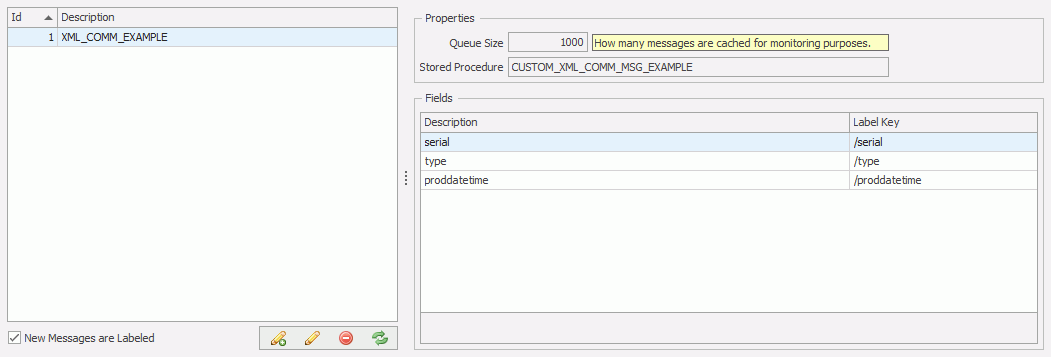Use the Messages window to display and manage all comm server message types.
Select the Services tab.
Click Messages (![]() ). The following screen will appear.
). The following screen will appear.

Click the Add button (![]() ) in the bottom left corner.
) in the bottom left corner.
In the Description field enter a unique description to identify the message.
In the Queue Size field enter how many messages can be cached for monitoring purposes.
In the Procedure list you can specify a custom stored procedure to be executed when a message is received.
Only stored procedures that have a name starting with CUSTOM_ will be listed.
If required, click Import Fields. The fields required for the stored procedure will be added to the Fields section.
In the Fields section specify the labels that the message will contain.
Please note that Label keys are case sensitive. If the Import Fields function is used, labels are imported in lower case. Please ensure that the Label keys match the case found in the input file.
Click the Add button (![]() ) in the Fields section to add a new label.
) in the Fields section to add a new label.

Enter a Description of the label (this doesn't have to be the actual label).
Enter a Label Key.
Click Save. The label is added to the list.
Click OK . The message is added.
Example Comm Service Stored Procedure
The example below details a stored procedure that can be used to return a custom error in Cockpit using a raiserror statement.
The stored procedure checks to see if the unit to be created already exists and if so, returns a custom error message that includes the Product ID and serial number provided to the stored procedure and sends it to the Comm Service.
/****** Object: StoredProcedure [dbo].[custom_comsvs_create_new_unit] Script Date: 9-3-2021 20:33:37 ******/
SET ANSI_NULLS ON
GO
SET QUOTED_IDENTIFIER ON
GO
ALTER procedure [dbo].[custom_comsvs_create_new_unit]
@productID int,
@Serial nvarchar(20)
as
begin
set nocount on
declare
@unitID int,
@plantID int,
@buildGroup int,
@modelyear smallint,
@prodDate date,
@serialno nvarchar(20)
-- Get current date and use this for production date
select@prodDate = getdate()
-- Get default build group
select@buildGroup = build_group_id
from build_groups
where is_default = 1
-- Get default plant
select@plantID =plant_id
from plants
where is_default = 1
-- Get current model year
select@modelyear = convert(smallint, datepart(yyyy, @prodDate))
--Parse Serial
if substring(@serial,1,2) = '??'
begin
select @serialno = substring(@serial,3,20)
end
else
select@serialno = @serial
-- Try to find unit
select top 1 @unitID = unit_id
from units
where serial = @SerialNo
and model_year = @modelyear
and product_id = @productID
order by unit_id
-- Quit if unit already exists
if @unitID >= 1
begin
raiserror('ERROR: Unit already exists, Product_id = %d. Serial = %s.', 18, 1, @productID, @Serial) with log
return
end
begin transaction
-- Insert Unit
insert into units
(product_id, plant_id, model_year, serial, lot_id,
build_group_id, prod_date, num_defects, num_unrepaired_defects, num_repaired_defects, num_confirmed_defects, is_locked)
values
(@productID, @plantID, @modelyear, @serialno, null,
@buildGroup,@prodDate, 0, 0, 0, 0, 0)
set @unitID = scope_identity()
-- Insert into Checklist Generation Queue to force checklist creation
insert into chk_generation_queue
(unit_id, is_force_create)
values
(@unitID, 1)
--Insert value in unit_lookup_codes, in this demo database lookup_type_id 23 is used to indicate the unit was created by comm service
insert into unit_lookup_codes (unit_id, lookup_type_id, lookup_code) values (@unitID, 23, 'Yes')
commit
end
An example error message is shown below.
